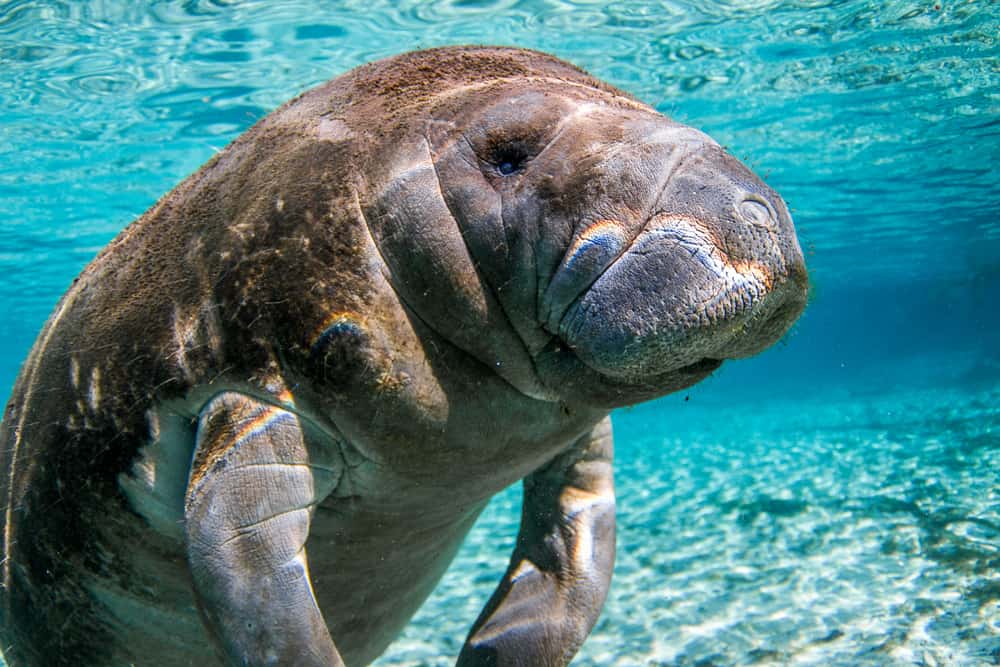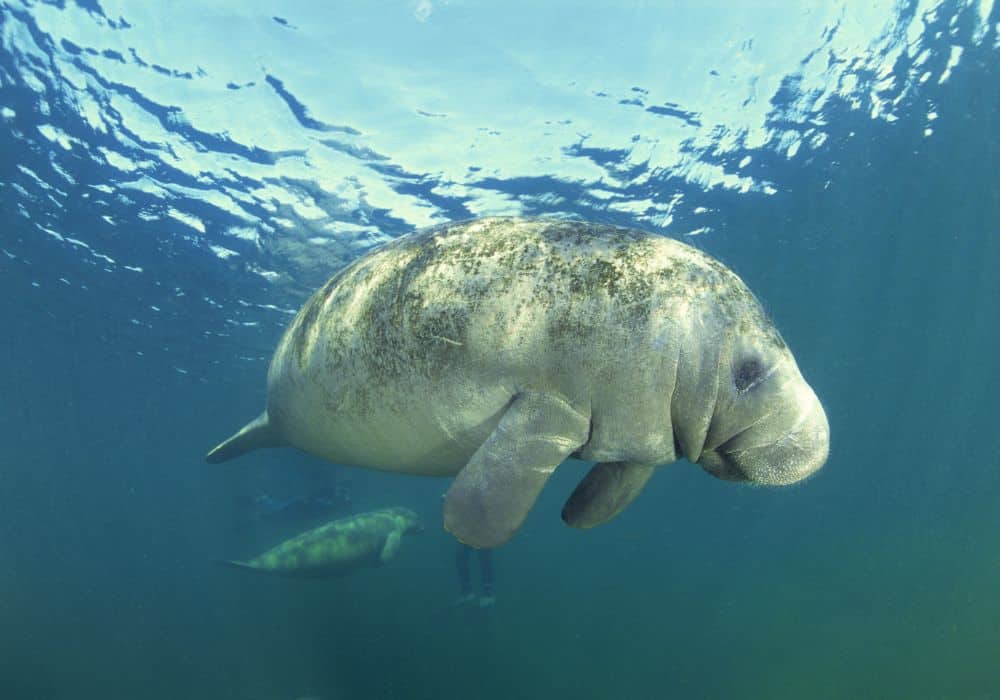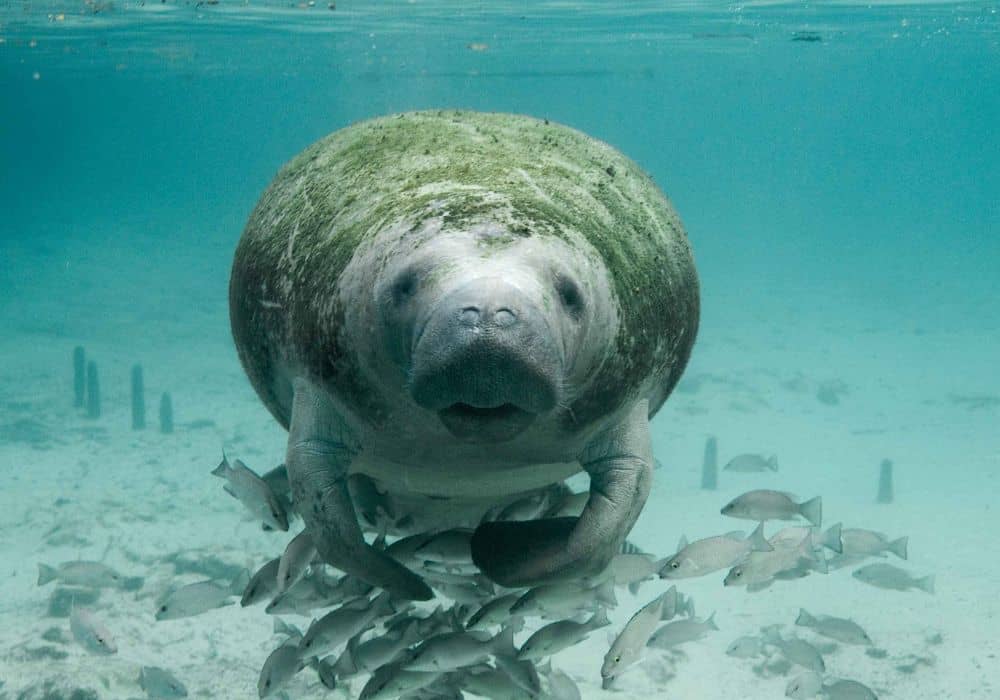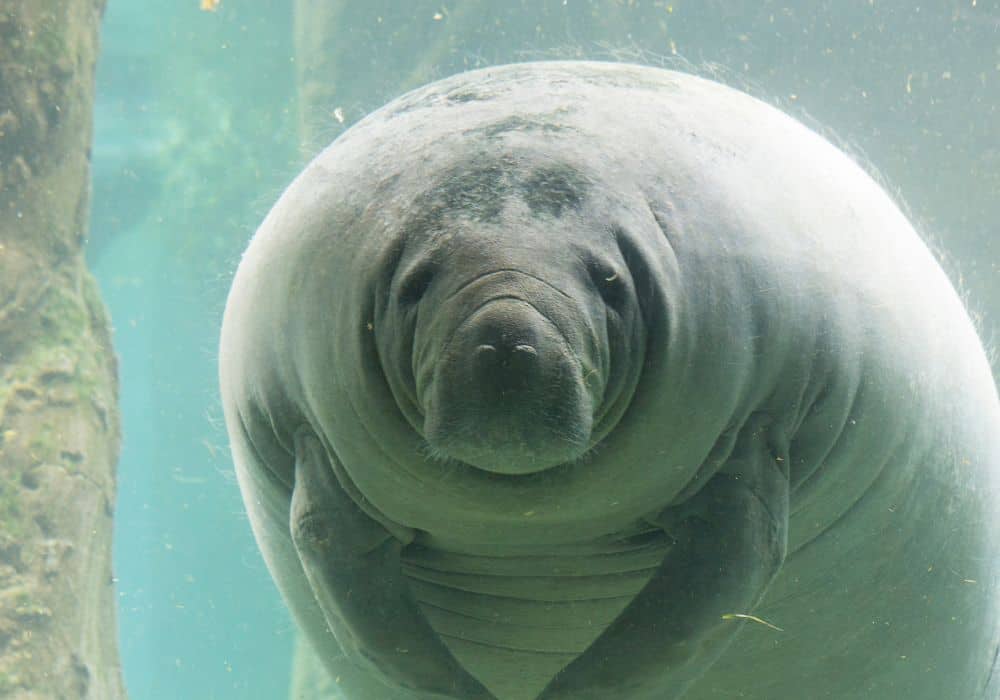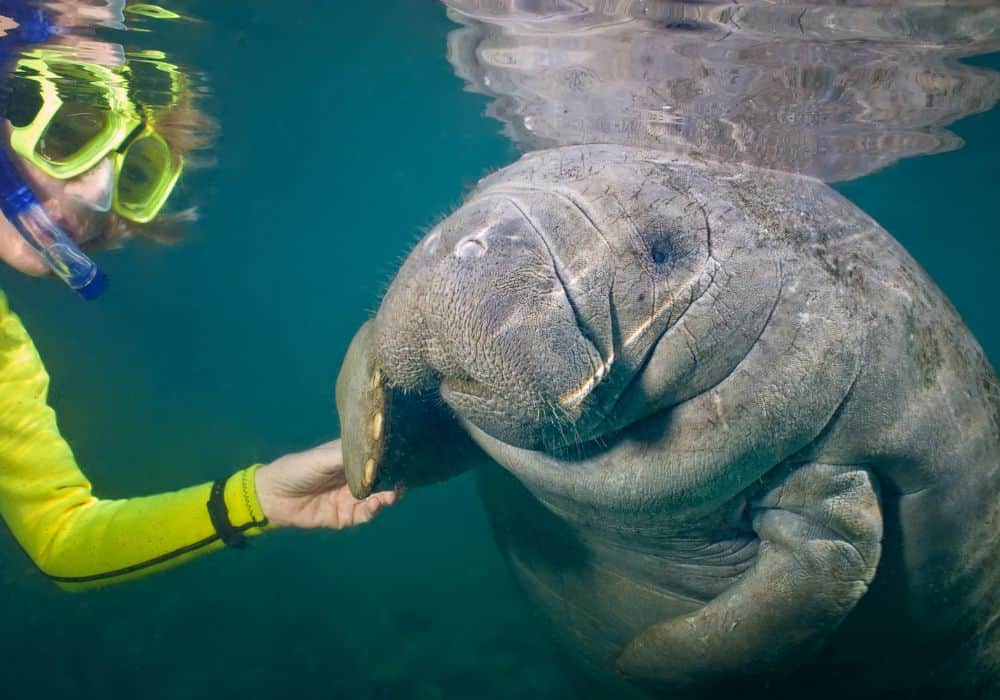Do you love manatees and wonder what they eat, their attribute, and how they behave? We are here to provide all the details you need about manatees. Manatees, also known as sea cows, are easy-going creatures that live inside river basins and warm coastal waters.
There are three species of manatees, and they are all fond of exploring their world while grazing. Manatees are herbivores animals, and they naturally weigh only about 1,000 lbs. Unlike many animals that live inside water and feed on other creatures, manatees depend on seagrass to maintain their body.
1. The Physical Characteristics of Manatees
Many people ask if manatees are associated with pigs or elephants. This question is a result of their physical appearance. Manatees are shaped like fish and have creased and hairy faces. Average adult manatees weigh 800-1000 lb and 9 to 13 meters. The female manatees are larger than the male ones.
These creatures have hairless skin split lips, a shovel-like and rounded horizontal tail, and paddle-like forelimbs. They have upper lips, which are mobile and divided, and mobile flippers, which they use in place of hands. Their egg-shaped head makes most people think they are related to cows; hence their name sea cows.
They have no visible ear, neck, or ear flap. The opening to their ear canals is positioned behind the eyes. Their eyes are about 2cm which means they are relatively small. Their teeth consist of 24 to 32 molars. Their lower and upper jaw also have rigged and horny pads that help crush plants. They also have rounded tails, which come in for of paddle shapes.
2. The Nature of Manatees
Manatees are gentle and curious. They often feel threatened by boats or people and make a loud noise when they see people around. Manatees are a bit selfish and will move closer to people or boats and become very nice and friendly if food is involved. They have a good sense of smell and hearing but horrible sight.
Due to their love for food, manatees ignore their instinct to flee when people feed them. This can expose them to danger and alter their expected self-protective behavior. They also have the characteristics of being able to hold their breath for close to 20 minutes to avoid water getting into their lungs through their nostrils.
3. The Distribution, Habitat, and Lifespan of Manatees
Manatees feed mainly in the morning and night, then use the remaining hours to sleep and perform other activities. They eat leaves found in the water and sometimes limp to the shores to grasp hanging plants. Since they have two hands, they use their lips to grip food in sight and push it into their mouth with flippers and bristles.
Manatees are not picky-eaters; hence they don’t mind eating whatever comes their way. These creatures have a very long lifespan and live for nearly 70 years in captivity. Female manatees reach maturity in 3-5 years while male ones reach maturity in 5-7 years.
The distribution of manatees is based on their lookout for appropriate habitat with enough fresh water source of water to drink and lots of aquatic plants to feed on.
By statistics, just half of all wild manatees that reach adulthood are expected to live in their early 20s. The typical lifespan of a manatee is between 30-40 years. The oldest manatees to have ever existed lived for 69 years. Collisions with barges and boats cause the death of manatees related to humans.
Manatees are migratory creatures found in different parts of the water in different seasons. Manatees inhabit brackish water, fresh water, saline water, bays, estuaries, coastal areas, and canals. They love an environment that provides fresh water and aquatic vegetation. Manatees cannot stay in cold water that has a temperature below 68º F.
They prefer warm water and will automatically migrate to areas with warm water during the winter seasons. Aquatic vegetations are important to manatees because they stabilize shorelines and sediments, increase water clarity, affect nutrient cycles, and provide food and habitat. Note that
- West African manatees live in connected lakes, large rivers, lagoons, and peaceful coastal areas with temperatures above 64°F.
- Amazonian manatees only stay in fresh water and are primarily found in channels in water and floodplain lakes with water temperatures between 25°-30°C.
- West Indian manatees live in water connected to the coast and are 3.25 ft deep. They prefer a temperature above 21°C
4. What do Manatees Eat?
It’s been established that manatees feed solely on a plant found in their environment. They consume different types of plants based on the environment they find themselves. Manatees consume hydrilla, tape grass, alligator weed, water hyacinth, lettuce, musk grass, celery, and pickerel weed in a freshwater habitat.
In a saltwater habitat, manatees eat sea clover, marine grass, seagrass, shoal grass, manatee grass, turtle grass, and marine algae. Manatees eat 60 species of submerged, shoreline, emergent, and floating vegetation. Manatees are always well-fed because they usually feed across different types of food.
Some manatees eat food that others don’t eat, and this is because of the habitat they find themselves in. No matter what they eat, their body is built to digest foods efficiently.
5. What do baby manatees eat?
Do you have little manatees and wonder what to feed them? Baby manatees often rely on their mother’s breast milk for the first couple of years after birth. The breast milk taken for two years is nutritious enough to make them grow healthy. Even though they feed on their mother’s breast, they are taught how to feed on plants once they are a couple of weeks old.
6. How much and how often do manatees eat?
On average, manatees eat between 30 to 100 pounds of weed and grass daily, equivalent to 5 to 9% of their body weight daily. Manatees eat a lot that they spend the first part of the day eating. In total, manatees spend close to 7 hours daily eating. Most of the food they consume has lower nutritional quality, hence the need to eat often.
Manatees are known as opportunistic feeders because they feed on plants tag comes their way. When they change the environment, they feed on plants and the food they come across. For example, they eat fish from nets or calms when no plant is around to graze on. Some manatees revert to eating small fish.
Manatees fast for the last two months of the year because, during this period, there is an inadequate water supply, and they don’t have enough food. These creatures can also go for a long time without food if the need arises. Don’t worry; your manatees won’t die from fasting because they have a low metabolic rate.
7. What not to feed manatees?
Even though manatees love food and live in water, it is wrong to give both water and food to manatees. They are wild animals, so giving them food and water will disrupt their natural diet and behavior and eventually put them in harm’s way. They may lose their fear of people and boat if they feed well.
This can make them approach an unknown dock or boat expecting food, only to be killed, injured, tamed, or harassed. Do not feed manatees lettuce
8. How do Manatees find food?
Since manatees only eat plants found in their habitat, they get vegetation from different parts of the water column. They graze on grass, leaves, acorn, and overhanging branches. To get food, manatees sometimes partially pull themselves out of the water to feed on vegetation that can be found on the river bank.
Manatees have two front flippers, which they use to crop and pull vegetation towards them. They also make use of the flippers to scoop vegetation and eat them. Flippers are essential factors when it comes to manatees finding what to eat. They also make use of flippers to browse through roots in the sand.
These animals also have lips which they use to tear plants. Their front flippers and firm lips manipulate different vegetation and guide them into their mouth. Although these creatures have no front teeth, they use their lower jaws and rigged pads to crush plants into smaller pieces to be easy for them to eat.
There is also a molar behind their pad that helps them chew and grind the food before swallowing.
FAQ:
1. What are manatees’ favorite food?
Manatees are herbivores animals that mostly feed on plants. They love all sorts of floating, emergent, and submerged plants. Manatees also love freshwater submerged aquatic vegetation and seagrass beds.
2. Do manatees eat their poop?
No! They don’t eat their poop. Manatees can taste other manatees’ poop to determine if the creature is sexually mature or not but do not eat their poop.
3. What can I feed manatees?
Feed manatees with different species of plants, including show grass, manatee grass, turtle grass, hydrilla, water hyacinth, mangrove leaves, acorns, and various algae. Also, you should provide manatees with fresh and clean water for drinking.
